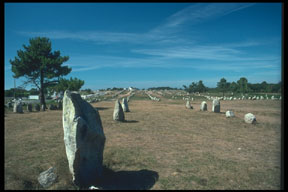A diagram showing the different rotation axes.
The Earth's Rotation
The Earth is rotating around an axis
(called its
rotational axis). Some objects rotate about a
horizontal axis, like a rolling log. Some objects, such as a skater,
rotate about a vertical axis. The Earth's axis is tipped over about
23.5° from vertical.
How do we define up and down in space? What would "vertical" mean?
For the Earth, we can think of vertical as straight up and down with
respect to the plane in which the Earth orbits the Sun (called the ecliptic).
Earth's rotational axis points in the same direction relative to the stars, so that
the North Pole points towards the star Polaris. Think of the Earth as
a spinning top, tipped over to one side. Over very long time periods (thousands of years) the direction of Earth's axis slowly changes due to precession.
The Earth rotates around once in 24 hours - that's a rate of 1000
miles per hour!. The time it takes for the Earth to rotate completely
around once is what we call a day. It's Earth's rotation that gives
us night and day.
The combined effect of the Earth's tilt and its orbital motion result in the seasons.
You might also be interested in:

Let's get rid of some common misconceptions about the seasons. The Earth's orbit is in the shape of an ellipse, so that sometimes the Earth is a little bit closer to the Sun than at other times. Is this
...more
If a body (like the Earth) is orbiting around the Sun, we say it is closest to the Sun at perihelion and farthest from the Sun at aphelion. In 2000, perihelion for the Earth was on January 3, 2000, and
...more
Some planets are tilted so their North and South Poles are not straight up and down. Earth is tilted a bit - about 23°. Uranus is tilted a lot - more than 90°. Mercury, on the other hand, is hardly tilted
...more
Mercury has a magnetic field. Its field is weak. Earth's magnetic field is tilted, and so is Mercury's. That means Mercury's magnetic poles are not in the same place as its geographic poles. Mercury has
...more
People from Asia crossed the Bering Strait into North America. These people were first in this new land and so they are known as Native Americans. Over time, these people broke into tribes (as seen on
...more
"The movements of the heavenly bodies are an admirable thing, well known and manifest to all peoples. There are no people, no matter how barbaric and primitive, that do not raise up their eyes, take note,
...more
The stones of Carnac, France, are probably the most famous stones markings outside of those found at Stonehenge in England. There are many, many stones at Carnac. And these stones are very old too, the
...more















